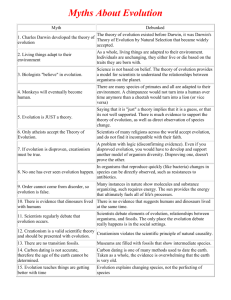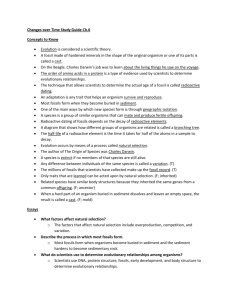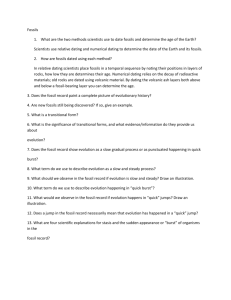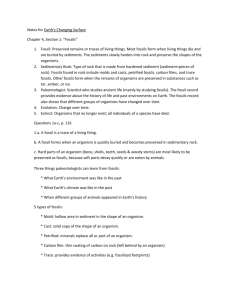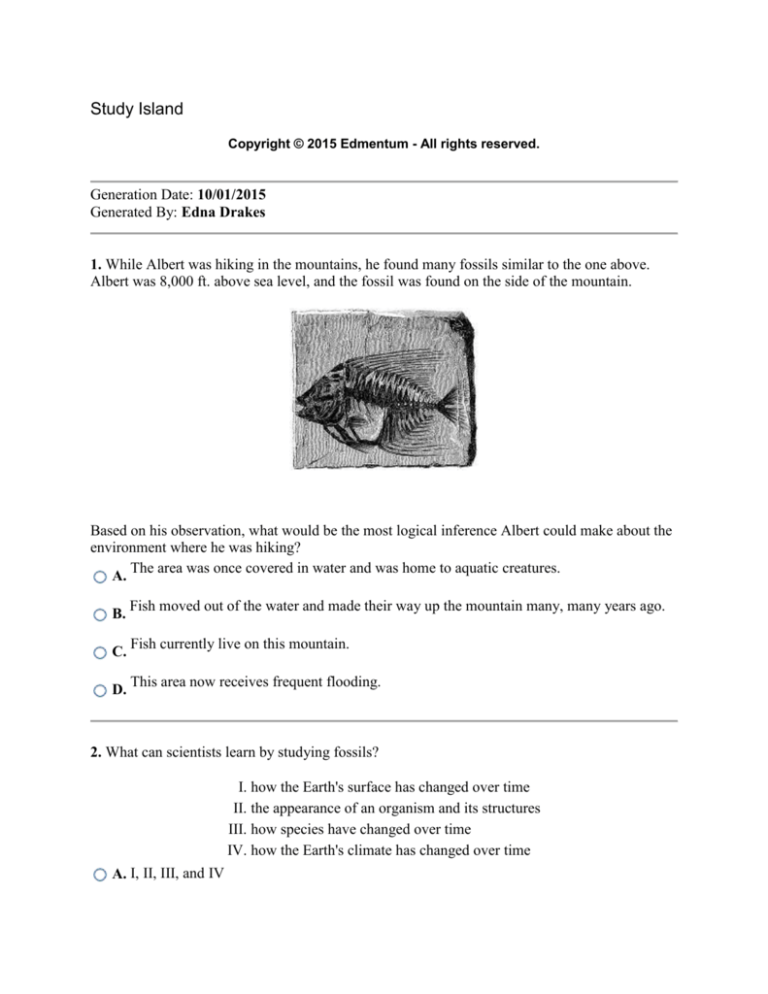
Study Island
Copyright © 2015 Edmentum - All rights reserved.
Generation Date: 10/01/2015
Generated By: Edna Drakes
1. While Albert was hiking in the mountains, he found many fossils similar to the one above.
Albert was 8,000 ft. above sea level, and the fossil was found on the side of the mountain.
Based on his observation, what would be the most logical inference Albert could make about the
environment where he was hiking?
The area was once covered in water and was home to aquatic creatures.
A.
B.
C.
D.
Fish moved out of the water and made their way up the mountain many, many years ago.
Fish currently live on this mountain.
This area now receives frequent flooding.
2. What can scientists learn by studying fossils?
I. how the Earth's surface has changed over time
II. the appearance of an organism and its structures
III. how species have changed over time
IV. how the Earth's climate has changed over time
A. I, II, III, and IV
B. II and III only
C. I, II, and III
D. II only
3. Scientists have found many fossil remains of an animal called an ammonite. This organism
lived millions of years ago, but it is now extinct. A picture of what an ammonite might have
looked like is shown below on the left.
On the right is a picture of an octopus, which is a living relative of the ammonite. What
conclusion can be drawn based on the pictures of the two animals?
A.
B.
C.
D.
Fossils are not helpful in learning which organisms might be related.
Organisms living today have nothing in common with organisms that lived long ago.
Organisms living today may be similar to organisms that lived long ago.
Organisms living today will probably be extinct in ten years.
4. Most of our understanding of the dinosaurs comes from
A. studying fossils.
B. studying live dinosaurs.
C. watching movies.
D. studying large animals.
5. Kyrien has found twenty fossils of the same type of extinct fern. What information could he
determine about the plants using measurements?
A. the average mass of the fern leaves
B. the average length of the fern leaves
C. the color of the fern leaves
D. the name of the fern species
6. Technology Enhanced Questions are not available in Word format.
7. A scientist recently found the fossilized remains shown below. He identified them as the
prehistoric organism Palaeobatrachus.
Palaeobatrachus resembled the modern _______.
A. bird
B. fish
C. frog
D. rodent
8. Many fossils found in the central United States look similar to marine animals that are alive
today. How could a paleontologist best show the similarities between fossils of seashells and
living shellfish to other scientists?
A. write the names of the fossils in a tables
B. write a paragraph about a fossil
C. make drawings of the fossils
D. show the size of the fossils on a graph
9. What is the main way we are able to learn about animals, like dinosaurs, that were extinct
before humans existed?
A. cave paintings
B. meteorites
C. fossils
D. weather patterns
10.
The image above shows a fossil of a fish that lived long ago. This fish is similar to fish that are
alive today.
Find the body structure labeled as "X" in the image. The fish most likely used this structure
to _______.
A. swim
B. fly
C. eat
D. walk
Answers
1. A
2. A
3. C
4. A
5. B
6. -7. C
8. C
9. C
10. A
Explanations
1. Fossils give us much information about how ecosystems have changed over time. Previous
ecosytems could be drastically different from the current ecosystems. As a result of the
environmental changes, one will observe changes in the types of organisms found in the area.
In this case, the area was once covered in water and was home to aquatic creatures.
2. Fossils provide a variety of information that scientists can use to learn about the Earth's past.
The fossils of organisms can reveal their appearance and structure, as well as how they have
changed over time.
The types of organisms that were present in various periods of Earth's history can provide
information about changes in the Earth's climate. Many organisms, for example, are known to
survive within narrow temperature ranges. If fossils of those organisms are abundant, then
scientists gain an important clue about the typical temperatures during that period.
Fossils can also provide information about how the Earth's surface has changed over time. If
fossils of marine organisms are found in areas that are now dry land, scientists may assume that
the area was once under water. This gives scientists important clues about land elevation,
landforms, and sea level at various times in Earth's history.
3. Organisms living today may be similar to organisms that lived long ago.
Offspring can be different from the parents in either large or small ways. This can mean that each
generation of offspring is a bit different from the last. Over a long period of time, these small
changes can produce a new kind of organism. This organism may be a little bit like the original
organism, or it may be very different. Some animals alive today came to be because some
ammonites survived and reproduced even when most of them died out.
4. Most of our understanding of the dinosaurs comes from studying fossils, which have
preserved the the physical features of organisms that lived millions of years ago.
5. Mass and length are both measurements, but the mass of a plant cannot be measured from it's
fossils. The appearance of a fossil is similar to the original plant. By measuring the fossils with a
ruler, he could determine the average length of the fern leaves when the fern was alive.
This information can be used to show how ferns have changed over time.
6. -7. Palaeobatrachus is a type of prehistoric frog with a broad skull and a large body. Scientists
think that they lived completely in water, unlike modern frogs, which spend some time on land.
Scientists use fossils to provide evidence for organisms that existed long ago. Sometimes, these
organisms are similar to modern organisms.
8. The sizes and the names of the fossils may be valuable information, but the best way to
compare a fossil to a living species is to make drawings of the fossils or to take photographs
and compare those images with pictures of the living species.
9. Fossils are the remains of ancient animals and plants, the traces or impressions of living things
from past geologic ages, and the traces of their activities. Fossil evidence tells us that dinosaurs
existed and reveals some information about their life.
10. The body structure labeled as "X" is a tail fin. Like most fish living today, the ancient fish
probably used its tail fin to help it swim.


